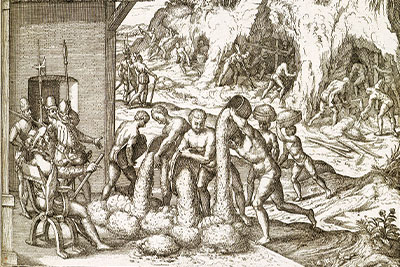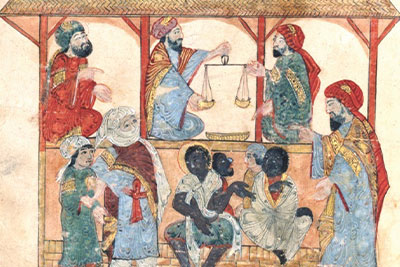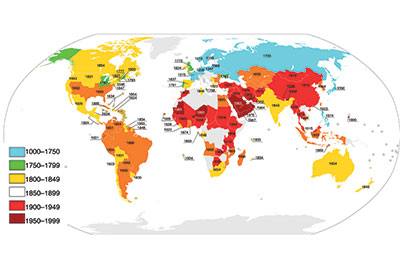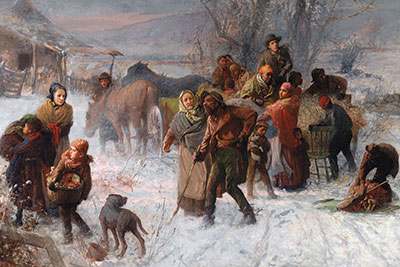America Did Not Invent Slavery — It Ended Slavery
A few years ago, I sat in church and listened to a preacher (a substitute for my pastor) who declared from the pulpit what a great and courageous man was William Wilberforce, the famous English abolitionist. The pastor then lamented that it was unfortunate that America did not have a William Wilberforce.
It is unfortunate that so much historical misinformation comes from the mouths of well-meaning individuals, such as this minister, but his statement illustrates the success of those who are not so well-meaning — those who want to distort history to advance the cause of the Left. To the secular progressives who largely run our institutions of education from kindergarten to graduate school, the mass media, the entertainment world, and now the corporate world, the issue is never the issue. The issue is power.
The “1619 Project,” promoted by the New York Times, is a bold effort to undermine the foundations of our constitutional republic by asserting that America was founded, not in 1776, but rather in 1619, when the first black Africans were brought to Virginia. According to this thesis, which is unsupported by the historical record, America was founded on the backs of African slaves, and practically every aspect of American history, including our Constitution, was tainted by the desire to implement and preserve the institution of slavery.
Therefore, since America was founded on slavery, its very founding is illegitimate, which means it needs to be transformed into a nation more to the liking of the secular progressives who promote this fictional view of U.S. history.
Students emerge from our schools believing that not only was our country founded on slavery, but America originated slavery, and only abolished it after just about nearly every other country had already done so.
Historian Kenneth Stampp promoted this ahistorical view in his book Peculiar Institution: Slavery in the Ante-Bellum South. In truth, slavery was neither “peculiar,” nor “original” to English America or, later, the United States. Writing in 1619: Jamestown and the Forging of American Democracy, James Horn explained that by the time the first Africans arrived in Virginia, “half a million slaves had already been shipped across the Atlantic to work in Spanish America and Brazil [Portugal’s New World colony].”
The late Walter E. Williams, the renowned economics professor at George Mason University, expressed similar sentiments in May 2019. Calling such false assertions as “America created slavery” a “favorite leftist tool,” Williams wrote, “Slavery is by no means peculiar, odd, unusual or unique to the U.S.”
The historical record is quite clear: Rather than originating in Colonial America, slavery has existed since we have had recorded history — and before. References are made to slavery as early as 3500 B.C. in ancient Sumer, the world’s first great civilization, founded in Mesopotamia (now in modern Iraq). The famous Code of Hammurabi of Babylon mentions laws concerning slavery around 1860 B.C. Slavery was part of the societies of ancient Egypt, China, Persia, Greece, India, the Roman Empire, the Arab Islamic Caliphate, the pre-Columbian civilizations of the Americas (such as the Aztecs, the Mayas, and the Incas), and the early kingdoms of Africa.
Individuals were slaves for various reasons, including debt slavery, punishment for crimes, child abandonment, and as prisoners of war. Some were born into slavery.
When Atlanta was being considered for the 1996 Olympics, members of the Olympic committee from West Africa expressed misgivings about locating the games in Georgia, a place where slavery existed prior to its abolition in 1865. Atlanta Mayor Andrew Young countered that while white Americans purchased slaves from Angola and other places in western Africa, it was the ancestors of the Africans themselves who sold them into slavery. This is true. Almost all those sold into the Atlantic slave trade were sold by black African kingdoms who had already enslaved them in Africa.

A really southern institution: Here slaves from Guinea dig in the gold and silver mines of Hispaniola (now Haiti/Dominican Republic) in 1595. The number of slaves used in the Spanish Empire was far greater than those in bondage in English America. (Photo credit: Wikimedia Commons /www.flickr.com/photos/britishlibrary/12459009143)
In fact, King Gezo of Dahomey (in West Africa) was angered when the British ended the slave trade: “The slave trade is the ruling principle of my people. It is the source and the glory of their wealth.” The king of Bonny (now Nigeria) was also disappointed when the British ended the slave trade.
This, of course, brings us back to that preacher who (rightly) praised William Wilberforce, a member of Parliament who struggled for years to end the slave trade and finally slavery itself in the British Empire. Wilberforce’s career well illustrates why the slave trade — and slavery — came to an official end in the world. The death of the ugly institution of slavery was a result of Western civilization. And the greatest impetus to Western civilization’s attack upon slavery was Christianity — Wilberforce became an ardent foe of slavery after his Christian conversion.
Christianity had largely ended slavery in Europe in the early Middle Ages (when many popes and other church fathers denounced it), and it was the conversion of Wilberforce in 1785, when he became an evangelical Christian, that led to its eventual demise in the British Empire. A member of the House of Commons for 45 years (which is a strong argument against “term limits”), Wilberforce was finally able to get Parliament to end the slave trade in the British Empire in 1807. Then, only three days before his death in 1833, slavery itself was abolished throughout the British Empire.
America Led the World in Abolitionist Efforts
But was it correct to lament that America did not have such a man as Wilberforce in our country? Actually, the institution of slavery had been under attack in America for several decades by men — and women — who decried the institution of slavery. Slavery was specifically declared illegal in Georgia when it became a colony in 1733, only to be legalized in 1750 by the king of England when it became a royal colony. When Vermont declared itself an independent republic in 1777, it abolished slavery at the same time. (Vermont was made the 14th state in 1791). Other states that ended slavery early included Pennsylvania in 1780; New Hampshire and Massachusetts in 1783; Connecticut and Rhode Island in 1784; New York in 1799; and New Jersey in 1804.
Another early action against slavery was taken in 1787, when Congress (under the Articles of Confederation) banned slavery in the Northwest Territory (now the present states of Ohio, Michigan, Illinois, Indiana, Wisconsin, and part of Minnesota). Interestingly, this was done at the insistence of Thomas Jefferson, who had tried to insert a condemnation of the slave trade into the Declaration of Independence.
All of these dates prove that, rather than being tardy in attacking the institution of slavery, America was the world’s leader in bringing the practice to an end. While Wilberforce is rightly commended for his multi-year struggle to abolish slavery in the British Empire, he did not accomplish that feat until 1833. By that time, slavery either had been ended or was being ended in several states in the United States, in some places more than a generation earlier than in the British Empire.
And it is not just that America’s abolition of slavery was accomplished earlier than in the British Empire. Abolition in America pre-dated almost the entire world. While Peter the Great abolished outright slavery in Russia in 1723, he converted Russians into serfs, and it was not until 1861 that serfdom finally ended in Russia. Mexico abolished slavery in 1829. France initially abolished slavery in 1794, but it was reestablished by Napoleon Bonaparte in 1802, before being permanently ended in the French colonies in 1848.

Not just a “white thing”: Perhaps the most prolific slave masters of the Middle Ages were the Arabs. Here, we see a painting of the sale of black Africans by Muslim slave traders in 13th-century Yemen. (Photo credit: Wikimedia Commons)
The abolition of slavery came to Bolivia in 1851; Ecuador in 1852; Peru, Argentina, and Venezuela in 1854; the Netherlands in 1863; Paraguay in 1869; Cuba in 1886; and Brazil in 1888. Abolition happened even later in other parts of the world, such as Korea, China, Saudi Arabia, and Yemen.
Although now officially illegal in all countries, the institution still exists, with an estimated 25-40 million now enslaved in Asia, and large numbers still enslaved in Africa. Children work as slaves today on cacao plantations in western Africa, for example.
While slavery was not abolished in all states of the United States until the passage of the 13th Amendment in 1865, the U.S. Constitution provided that Congress could ban the importation of slaves into the country in 1807 — which Congress did on March 2 at the urging of President Thomas Jefferson. Wilberforce’s bill had passed about a week earlier.
Indentured Servants and Slaves in America
By the time the importation of slaves was banned in 1807, and slavery was finally abolished in 1865, slavery had existed in America since the 1600s, when it was still part of the British Empire. The 1619 Project errs, however, in asserting that slavery began in Virginia in 1619. The first black Africans, who had been slaves in Africa, did arrive in 1619, but they did not become slaves in Virginia. John Rolfe, a prominent resident of Virginia, reported their arrival to Sir Edwin Sandys, which took place on August 20, 1619: “A Dutch man of war of the burden of 160 tons arrived at Point Comfort, the commander’s name Capt. Pope, his pilot for the West Indies one Mr. Marmaduke, an Englishman.… He [Pope] brought not anything but 20. And odd Negroes, which the Governor [Sir George Yeardley] and Cape Merchant bought for victuals [food or provisions].”
Famed historian Paul Johnson, in his A History of the American People, wrote, “These men were unfree though, not strictly speaking, slaves. They were indentured servants.… White laborers arrived from England under the same terms, signing their indentures [contracts], or making their mark on them, in return for passage to America.”
In 1625, the black Africans were listed as servants, just like the white servants, in that year’s census. Laws governing slavery would not exist in Virginia for several more years.
Historians now believe that Rolfe may have been mistaken in writing that it was a Dutch ship that brought the first black Africans to Virginia. It is now thought that two English pirate ships took over a Portuguese ship in the Gulf of Mexico, then went to Virginia with their cargo, which included African slaves from Angola. As there was no market for slaves in England, the men — who had been slaves in Africa — became indentured servants in Virginia.
Indentured servants were generally released from their contract after a period of a few years, and would usually be given some land on which to farm. While indentured-servant status was not a pleasant existence, it was not slavery. It is not known whether any of these indentured servants from that first ship in 1619 lived to see both freedom and land, but many Africans who arrived in Virginia did.

Color me honest: As this map graphically demonstrates, slavery was generally abolished much earlier in parts of the United States than in most of the rest of the world. The common remarks that slavery was somehow unique or original in Colonial America and the early United States is a massive falsehood. (Photo credit: Wikimedia Commons/Borysk5)
For example, Anthony Johnson was an Angolan who, after finishing his indenture, obtained land and became a tobacco farmer. By 1651, he had a 250-acre farm and five black indentured servants of his own. He even managed to own a slave before it was legal to do so. One of his black servants, John Casor, demanded his release in 1654 and went to work for a white man, Robert Parker. Johnson successfully sued Parker and the court sentenced Casor to a lifetime of indentured servanthood as punishment for breaking the terms of his indenture.
Ironically, it could be argued that the first slave owner in Virginia was a former black indentured servant from Africa. Not until 1670 did Virginia enact laws governing actual slavery. Maryland had done so in 1664, when there were only 300 blacks in that colony.
Still, few slaves populated any of the English colonies until the next century. The 1625 census of Virginia listed 23 blacks. In 1640, only 20 were identified in Maryland.
It was this slow growth of the institution of slavery that historian Paul Johnson asserts caused the gradual corruption of society to accept it. In other words, the people living at the time could not have predicted the eventual negative effects slavery would have on American history. By the time questions were raised about an institution that had existed throughout recorded history in all cultures and on all continents, the institution of slavery was deeply entrenched into the American culture and economy.
Rather than creating the institution of slavery, many Americans fought to abolish it. It is simply incorrect to argue that America should have had a William Wilberforce, when America had many like him. Quakers and Baptists were among the earliest abolitionists in Colonial America. Thomas Jefferson spoke often of the evils of slavery. “I tremble for my country when I reflect that God is just; that his justice cannot sleep forever,” Jefferson said in reference to slavery. George Washington freed his slaves. Alexander Hamilton and John Adams both supported abolition.
America’s Many Abolitionists
John Randolph, a cousin of Jefferson and a descendant of John Rolfe and his Indian wife, Pocahontas, became an ardent opponent of slavery. He described the horror of a slave auction, in which a slave woman was going to have her children taken from her. “The greatest orator I ever heard was a woman. She was a slave. She was a mother, and her rostrum was the auction block.”
Randolph inherited a plantation with slaves, and worked many years to free the estate from debt, so he could emancipate his own slaves. Not only did he free them, he purchased land for them in the free state of Ohio.

Sainted souls, here and there: While much attention has been rightly paid to the work of British abolitionist William Wilberforce, abolitionism was even more prominent in the United States. One striking example of extensive abolitionist efforts was the “Underground Railroad,” which used safe houses to help thousands escape from slavery. (Photo credit: Keith Lance/DigitalVision Vectors/Getty Images)
William Lloyd Garrison, a strong abolitionist, had a rope tied around him and was dragged through the streets of Boston. An Illinois mob murdered abolitionist Elijah Lovejoy, the editor of a newspaper in Alton, Illinois, and both he and his printing press were thrown into the Mississippi River. John Greenleaf Whittier, a Quaker from New England, lost publishing opportunities for his literary works because of his public opposition to slavery. In Connecticut, a woman was jailed for teaching blacks to read.
Despite such intense opposition, abolitionists persevered. Following the Mexican War, the discovery of gold in California caused such a tremendous increase in that area’s population that it quickly needed to become a state. The “problem” was that California wanted to enter the Union as a “free state,” where slavery would be illegal, and this would give the “free” states a one-state majority over the “slave” states. This led to the Compromise of 1850, which stated that California would enter the Union as a “free” state, but also provided a draconian fugitive slave statute, under which a person could be jailed for helping a slave to escape.
The Fugitive Slave Law was extremely unpopular in the many states that had already abolished slavery, and many resorted to “nullification” to frustrate its enforcement. Nullification is a doctrine first advocated by Thomas Jefferson and James Madison in opposition to an attempt by Congress to suppress freedom of speech and freedom of the press in 1798. According to their nullification doctrine, states should interpose themselves between their citizens and the federal government if the federal government tries to enforce an unconstitutional law in their state.
Wisconsin’s Supreme Court declared the Fugitive Slave Law unconstitutional, and its Legislature even claimed the right to secede from the United States if the national government persisted in forcing obedience to the law. Vermont passed a law forbidding the return of fugitive slaves. Other states fined law officers who assisted in the capture of an alleged runaway slave, and revoked the law licenses of lawyers who represented the owner of a fugitive slave. Massachusetts even enacted legislation that said a law officer could be imprisoned for five years if he helped enforce the Fugitive Slave Law.
The Underground Railroad
Many people, both black and white, actively helped slaves escape, even though it could have put them in legal jeopardy. The “Underground Railroad” was one such example. Neither underground nor a railroad, it was rather a system of well-planned routes of escape for slaves. Houses, barns, and other dwellings, about 20 miles apart, where the fugitive slaves could be concealed during the day, were called the “stations” of the road. When night fell, the runaways would then be taken to their next station. Some went all the way into Canada on this “railroad.” Levi Coffin, a Quaker, was dubbed the “president” of the Underground Railroad, because he aided in the escape of more than 3,000 slaves. Many famous “conductors,” such as Harriet Tubman, a former slave herself, assisted slaves on the “railroad.”
Frederick Douglass was among the more famous black abolitionists. Born a slave in Maryland, Douglass managed to escape to the North, where he took up the abolitionist cause as a gifted orator, writer, and editor. After the Civil War, he was appointed U.S. ambassador to Haiti.
After she heard Douglass speak in Bristol, England, in 1846, Mary Estlin praised him in a letter to an American abolitionist. “There is but one opinion of him. Wherever he goes he arouses sympathy in your cause.… Our expectations were highly roused by his narrative, his printed speeches, and the eulogisms of the friends with whom he has been staying: but he far exceeds the picture we had formed both in outward graces, intellectual power and culture, and eloquence.”
If his words then are any guide to what he would say now, we can safely assume that Douglass would disagree with those who argue that America was founded upon slavery. On the contrary, Douglass revered the Declaration of Independence and the Constitution of the United States, calling them “liberty documents.”
Rather than accept the vile accusations of the 1619 Project and other radical criticisms saying that the founding of America was centered around slavery, and that slavery was America’s “original sin” and our “peculiar institution,” Americans need to stand up to those who would distort our nation’s founding. America did not originate slavery, but was actually a leader in its ultimate demise.

